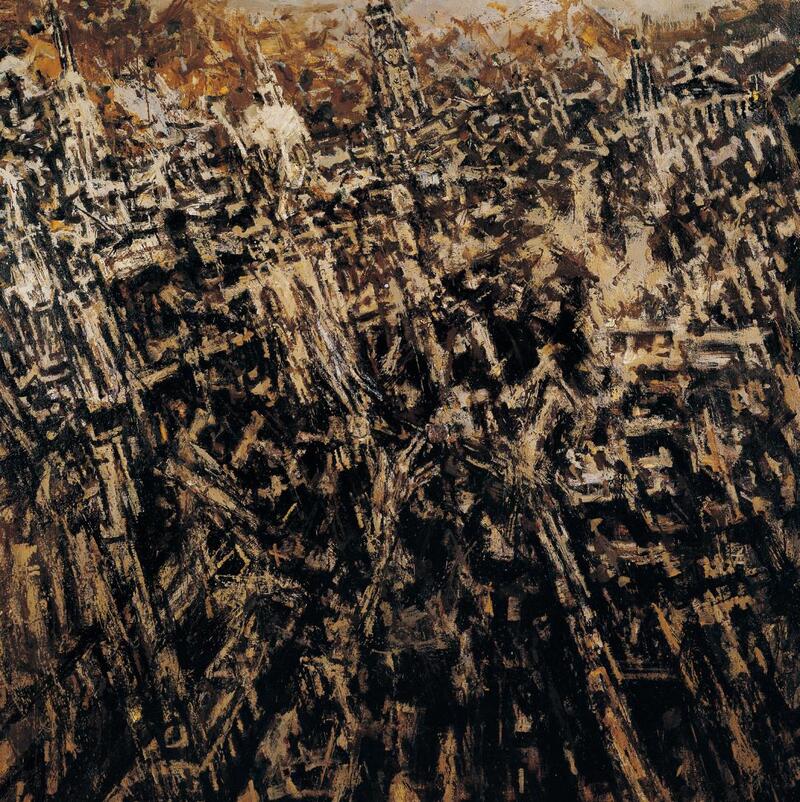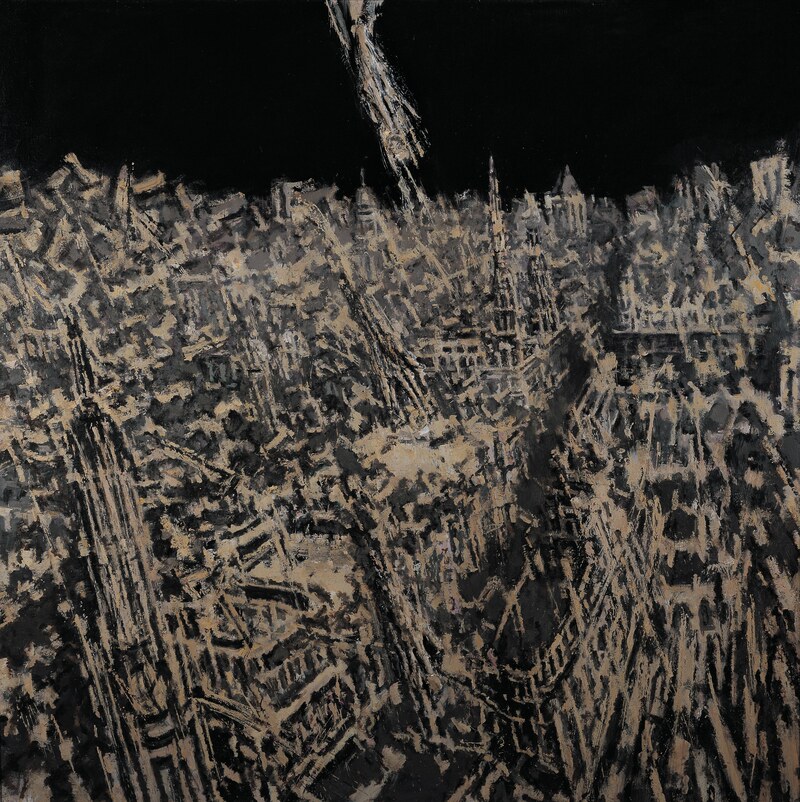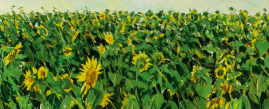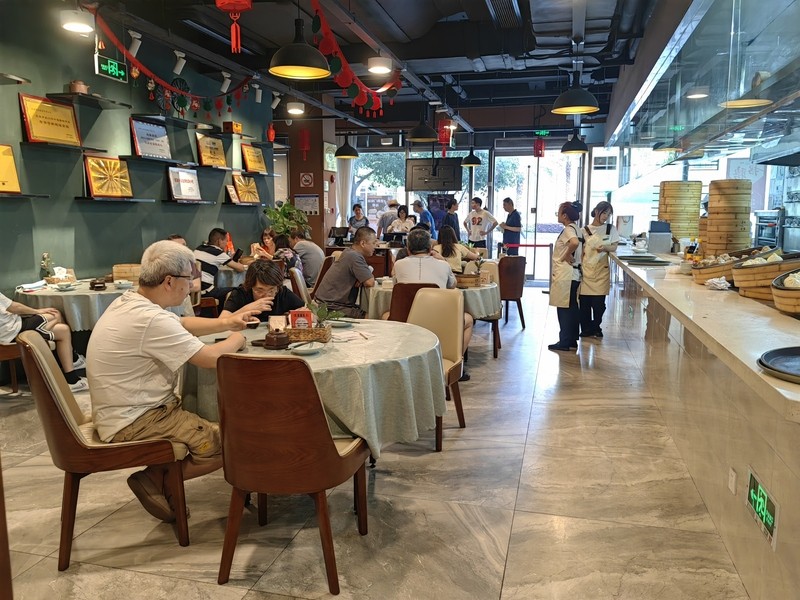Have you ever seen Shanghai under Xu Jiang's pen? With his paintings, he opens up a vision for the soul. Shanghai, Old Nanjing Road | Works | Shanghai
"Wang" is a big character in Chinese culture and a wonderful character in people's spiritual life.
Recently, Xu Jiang, former dean of the China Academy of Fine Arts and painter, held a solo exhibition called "Far sighted" at the Jiushi International Art Center in Shanghai.
From "Looking at the Sea" and "Watching the Kuiyuan Garden" to "Looking at the Mountains and Waters", Xu Jiang presents his artistic trajectory and emotional journey of more than 20 years in "Looking". "Wang" is his creative method and philosophy of life.
For the audience, "far sightedness" in art is a spiritual need.

20 years ago, questioning and entanglement
It was only 20 days before the opening of the exhibition that "Far Sight" was confirmed to be held at the Jiushi International Art Center on the Bund. 20 years ago, Xu Jiang painted a batch of works about old Shanghai. Now, this batch of works has returned to the historical scene, leading the audience to experience a spiritual vision. Xu Jiang told the reporter, "Today, standing here, I feel like I have suddenly returned to the origin of homesickness."
"Yuanwang" was the title of a large-scale personal exhibition held by Xu Jiang at the China Art Museum in 2006. Over the past 17 years, he has been the person who has been constantly looking far away, and also the one who has been summoned and shaped by Far Sight.
Xu Jiang's canvas oil painting "The Old Bund of Shanghai" from 2000

The painting "The Old Bund of Greater Shanghai", created in 2000, depicts the familiar Bund: the HSBC Building, Customs Building, Peace Hotel, and the Asia Building at No.1 Zhongshan East Road, where the exhibition is located, are all faintly recognizable. And this kind of bird's-eye view, represented by heavy colors, is unfamiliar. Upon closer inspection, there are actually two raised hands in the visual center of the picture, with chess pieces on hand.
"More than a hundred years ago, many forces played games on the Bund, creating this unique horizon. In this work, I use the imagery of 'flipping hands over playing chess' to express my questioning of the history of this city." Xu Jiang explained the hand and chess in the painting. Similar hands also appear in works such as "Old Nanjing Road in Shanghai", in which one hand seems to descend from the sky, exploring history in chaos and entanglement.
Xu Jiang's canvas oil painting "Old Nanjing Road in Shanghai" from 2000
Those familiar with Xu Jiang know that "flipping hands over playing chess" was the most important artistic imagery during his early immersion in conceptual art. In 1989, he created the concept installation work "God's Chess" in Germany. For many years thereafter, he often played chess in his works. Young Xu Jiang once struggled with many artistic concepts, attempting to abandon oil painting materials and find more direct ways of expression. It was not until the year 2000 when he created the "Great Shanghai" series of works that he gradually returned from spatial art to easel painting. "I experienced a period of artistic 'return of a traveler', and the process of returning home was painful."

In 2000, Xu Jiang led a team to prepare for the third Shanghai Biennale. He set the theme of that exhibition as "Shanghai on the Sea", exploring the modernity of the city. "A hundred years ago, someone wrote an article exploring the characteristics of Shanghai, believing that Shanghai could create its own legend, and that there was a kind of fluidity towards goodness in this city. A hundred years later, the huge changes in Shanghai confirmed this' prophecy '. Xu Jiang said,' In 2000, while planning the Shanghai Biennale, I was also questioning the historical fate of the city in my own creations. During the questioning, I gained something and also became entangled. Today, when I look back at these works from back then, I am also slightly shocked. Compared to my later works, they are more entangled, more vicissitudes, and more solemn. '"
"Looking South at the Bund" was created in 2023, featuring a weather signal station on the Bund. From the window of the exhibition hall, one can see the building that still stands on the Bund. Although the color of this painting exudes a sense of historical vicissitudes, it clearly carries more poetic qualities compared to the batch of works from 20 years ago.
Xu Jiang's paper oil painting "Looking South from the Bund" in 2023
Painting Kui is painting sentient beings

In 2003, Xu Jiang met a vast area of sunflowers on the wasteland near the Marmara Sea in Türkiye. He still remembers the scene: the sun is slowly setting, and the sunflowers are like a group of veterans standing there waiting for the last military order. Not far away is the ruins of the Trojan War, a land that carries a thousand years of history, and the sunflowers ripen once a year. This contrast of time brings Xu Jiang an unexpected life experience. In that sunflower patch, I seemed to see myself, and my life memories were activated at that moment. That moment became a decisive moment in Xu Jiang's future creative career.
Artist Qiu Zhijie once said, "Xu Jiang ran into the Kui Garden and never came back." In order to paint Kui, Xu Jiang became a fan of Kui. He has been to the Gobi in Xinjiang, the grasslands in Inner Mongolia, and the fields by the sea... For 18 years, he has painted big Kui, small Kui, huge Kui, and residual Kui, as well as spring Kui, summer Kui, autumn Kui, and snow Kui.
The second part of the exhibition is called "Kuiyuan Watching". In the exhibition hall, Xu Jiang and reporters shuttle through the Kuiyuan World he has built over the years. "For me, sunflowers are not only natural species, but also spiritual species. The sunflowers I paint all have a bit of bitterness and a bit of vastness." Xu Jiang said, "In the sunflower garden in the northwest, the sunflower harvesters told me that when they harvest sunflowers, they will use scissors to cut off their heads for several hours. In winter, the sunflower stalks that cannot be seen at a glance tremble in the snow, and this scene is called vastness."
Sunflowers are usually over one meter tall, some even taller than humans, and the sunflower plate is like the face of all beings. When facing the sunflower plate, it is like having a conversation with a life. Xu Jiang has painted many close-up shots of Kui Pan. In this exhibition, he selected 26 "faces" to form a set of "Kui Yuan Portraits", which is unforgettable.

Xu Jiang's Portrait of Kuiyuan Paper Watercolor 2018
"Chinese people have always had a worldview of plants and trees, and expressing people's hearts through plants and trees is a very important core in traditional culture. In ancient times, plum blossoms, orchids, bamboo, and chrysanthemums were often used to sing about the noble spirit, but using plum blossoms, orchids, bamboo, and chrysanthemums to portray the Chinese people of the 20th century seems not enough. However, kui can be used. Kui faces a more harsh natural environment, has a more resilient personality, and has a collective spirit, especially able to express the experiences of our generation. For Xu Jiang, painting kui is painting people, and the spiritual images of their generation are buried in kui.".
The Dean of the Chinese Academy of Fine Arts, Gao Shiming, understands Xu Jiang's persistence towards sunflowers as follows: "Xu Jiang searched for, painted, and praised sunflowers not only for self-awareness, but also to depict the thoughts and spiritual map of a generation. This is the unique life experience of Xu Jiang's generation - ideals, vicissitudes, resilience, stubbornness, loneliness but not decadence, desolation but not sadness. This generation, which once bloomed in the sun, uses time as a pen and vicissitudes as a painting, and receives nourishment through hardships."
Xu Jiang's "Life Like Summer Flowers" Part 2015

Clouds and mountains are vast, and rivers are magnificent
In the past three years, Xu Jiang, who has pursued numerous distant landscapes, has found new creative inspiration in the beautiful landscape of Jiangnan. His footsteps have traveled throughout various parts of central Zhejiang, including Longquan, Tiantai Mountain, Fuchun River, and Yandang Mountain... As we enter the third part of the exhibition, "Landscape Observation," it feels like we have entered a world full of poetic landscapes.
There are many descriptions of the Fuchun River in literary works from ancient times to the present day. Xu Jiang said that when he was sailing from Tonglu to Jiande on a boat, he remembered the poem written by Wu Jun of the Northern and Southern Dynasties: "The wind and smoke are all clean, and the Tianshan Mountains are of the same color. From the flowing river, anything can be seen. From Fuyang to Tonglu for over a hundred miles, there are strange mountains and rivers, and the world is unique.". As he passed by the Yan Ziling Diaoyu on the banks of the Fuchun River, he remembered Fan Zhongyan's famous poem "Record of Mr. Yan's Ancestral Hall": "The clouds and mountains are vast, the river is magnificent, the gentleman's style is high, and the mountains are long." Inspired by the beautiful scenery and timeless classics, Xu Jiang used a set of paper oil paintings to express the charm of the Fuchun River as "the clouds and mountains are vast, and the river is magnificent.".
Xu Jiang's paper oil painting "Cloudy Mountains, Cang Cang, Jiang Shui Yang" in 2021

Beside the scenery of Fuchun River, there is a group of works depicting Tiantai Mountain in Zhejiang. The Sui Pagoda of Guoqing Temple and the pine trees of Tiantai Mountain both exude unique meanings. In this batch of new works, Xu Jiang used a large amount of emerald green, which is not common in oil paintings. He wanted to use this green to express a vitality and express the majesty of mountains and rivers.
"I have seen the grandeur of the mountains and rivers in the north, and in recent years, I have been deeply moved by the mountains and rivers in Jiangnan, especially in Zhejiang." Xu Jiang said, "The mountains and rivers in Zhejiang are very important in the history of Chinese landscape painting. The mountains in Zhejiang are not very high, but they have their own characteristics. Ancient people often followed the river to see the mountains, and with the changes in water conditions, one mountain after another came rushing towards me. Moreover, there are often clouds and smoke on the mountains, which constantly change, and the scenery in the mountains is also changing. This kind of smoke mountain has a unique flavor."
Xu Jiang's "Travel to Fuchun Mountain - Lilong Smoke Village" canvas oil painting in 2023
"Xu Jiang's works are very similar to Chinese oil paintings, but unlike his predecessors who explored the nationalization of oil painting in the early 20th century, he faced nature and mountains and rivers with his experience of painting history. His brushstrokes were willful. Therefore, compared with pure landscape paintings, these works have more spirituality and sublimity." Gao Shiming really likes these new works. "Xu Jiang's brushstrokes are more sensitive, free, and old, but he still maintains his usual toughness and stubbornness. Among the hills and trees, one can feel the historical vicissitudes that run through the ruins, cities, wastelands, and sunflower gardens he used to depict from all directions." Kuiyuan belongs to the mountains and rivers of Jiangnan, while Xu Jiang's chest still sways with the wind on the earth's wilderness. What is seen in the picture is not only the mountains, rivers, forests, and springs, but also the years of mountains and rivers





